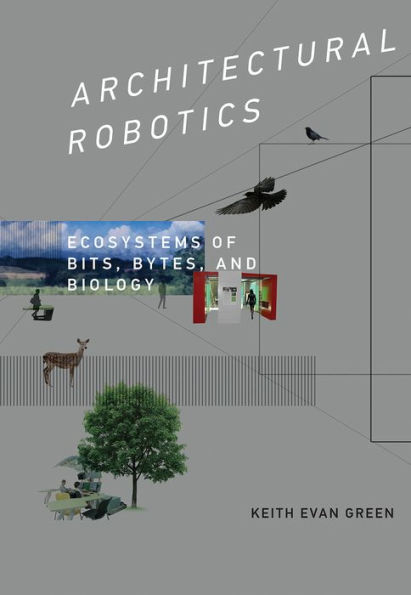
Architectural Robotics: Ecosystems of Bits, Bytes, and Biology
288
Architectural Robotics: Ecosystems of Bits, Bytes, and Biology
288eBook
Related collections and offers
Overview
The relationship of humans to computers can no longer be represented as one person in a chair and one computer on a desk. Today computing finds its way into our pockets, our cars, our appliances; it is ubiquitous—an inescapable part of our everyday lives. Computing is even expanding beyond our devices; sensors, microcontrollers, and actuators are increasingly embedded into the built environment. In Architectural Robotics, Keith Evan Green looks toward the next frontier in computing: interactive, partly intelligent, meticulously designed physical environments. Green examines how these “architectural robotic” systems will support and augment us at work, school, and home, as we roam, interconnect, and age.
Green tells the stories of three projects from his research lab that exemplify the reconfigurable, distributed, and transfigurable environments of architectural robotics. The Animated Work Environment is a robotic work environment of shape-shifting physical space that responds dynamically to the working life of the people within it; home+ is a suite of networked, distributed “robotic furnishings” integrated into existing domestic and healthcare environments; and LIT ROOM offers a simulated environment in which the physical space of a room merges with the imaginary space of a book, becoming “a portal to elsewhere.”
How far beyond workstations, furniture, and rooms can the environments of architectural robotics stretch? Green imagines scaled-up neighborhoods, villages, and metropolises composed of physical bits, digital bytes, living things, and their hybrids. Not global but local, architectural robotics grounds computing in a capacious cyber-physical home.

Product Details
| ISBN-13: | 9780262334228 |
|---|---|
| Publisher: | MIT Press |
| Publication date: | 02/10/2016 |
| Series: | The MIT Press |
| Sold by: | Penguin Random House Publisher Services |
| Format: | eBook |
| Pages: | 288 |
| File size: | 19 MB |
| Note: | This product may take a few minutes to download. |
| Age Range: | 18 Years |
About the Author
Table of Contents
Preface ix
Acknowledgments xi
Prologue
1 Scenes From a Marriage 1
2 Of Metaphors, Stories, and Forms 7
I Reconfigurable
3 Spaces of Many Functions 23
4 In Awe of the New Workflow 41
5 The Reconfigurable Environment 68
II Distributed
6 Living Rooms 71
7 The Art of Home+ 85
8 The Distributed Environment 126
III Transfigurable
9 Portals to Elsewhere 129
10 A Lit Room for the Persistence of Print 137
11 The Transfigurable Environment 170
Epilogue
12 Ecosystems of Bits, Bytes, and Biology 173
Notes 205
Bibliography 233
Index 249
What People are Saying About This
No more Jetsons technofuturism! Here amid the craze for automatic everything, from driverless cars to social network bots to beds smart enough to tell you how well you have slept in them, it is time for more thoughtful debate. Now as even architecture gets into the act, Keith Evan Green provides a more humane, engaging approach to tangible interface in what he calls 'cyber-physical systems.' Here is a longer historic perspective from design masters past, a close-up look at implementing responsive rooms today, and a deep dive into the philosophical question of what brings architecture to life.
Packed with detail from real projects, this book provides dozens of insights into not just how but more importantly why our interactive architectural machines, environments, and cities are increasingly embedded with computing and sensor technologies—and why this might be enchanting.
Yet more evidence of the impending robot uprising. This book advances robotics not by making robots smarter, but by transforming the places people inhabit into robots. It challenges our provincial idea of robots moving around inside of buildings. Now the buildings are all robots.
Packed with detail from real projects, this book provides dozens of insights into not just how but more importantly why our interactive architectural machines, environments, and cities are increasingly embedded with computing and sensor technologies—and why this might be enchanting.
—Usman Haque, founding partner, Umbrellium
No more Jetsons technofuturism! Here amid the craze for automatic everything, from driverless cars to social network bots to beds smart enough to tell you how well you have slept in them, it is time for more thoughtful debate. Now as even architecture gets into the act, Keith Evan Green provides a more humane, engaging approach to tangible interface in what he calls 'cyber-physical systems.' Here is a longer historic perspective from design masters past, a close-up look at implementing responsive rooms today, and a deep dive into the philosophical question of what brings architecture to life.
—Malcolm McCullough, Professor of Architecture, Taubman College, University of MichiganYet more evidence of the impending robot uprising. This book advances robotics not by making robots smarter, but by transforming the places people inhabit into robots. It challenges our provincial idea of robots moving around inside of buildings. Now the buildings are all robots.
—John Zimmerman, Associate Professor, Human-Computer Interaction Institute, Carnegie Mellon UniversityPacked with detail from real projects, this book provides dozens of insights into not just how but more importantly why our interactive architectural machines, environments, and cities are increasingly embedded with computing and sensor technologies—and why this might be enchanting.
—Usman Haque, founding partner, Umbrellium